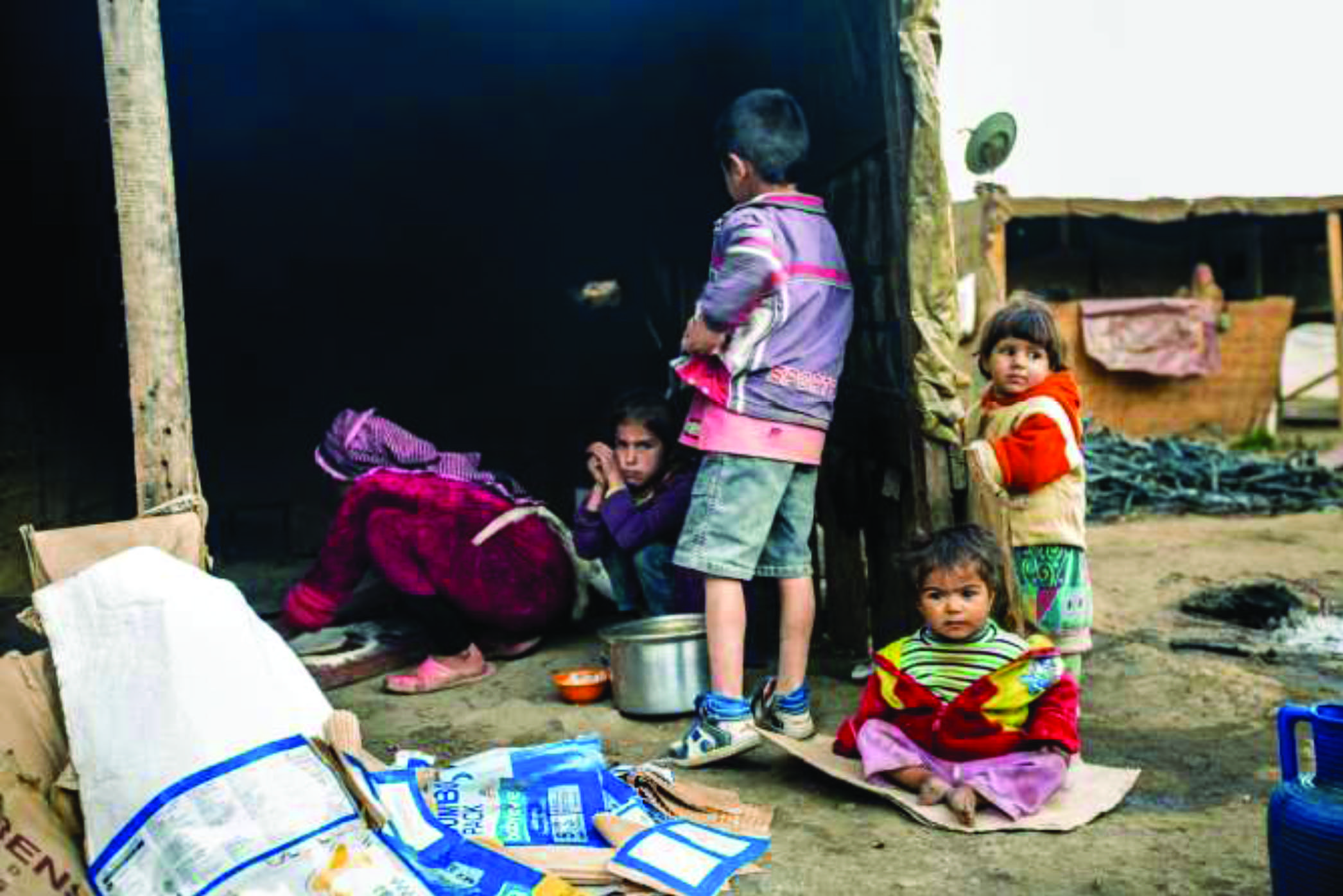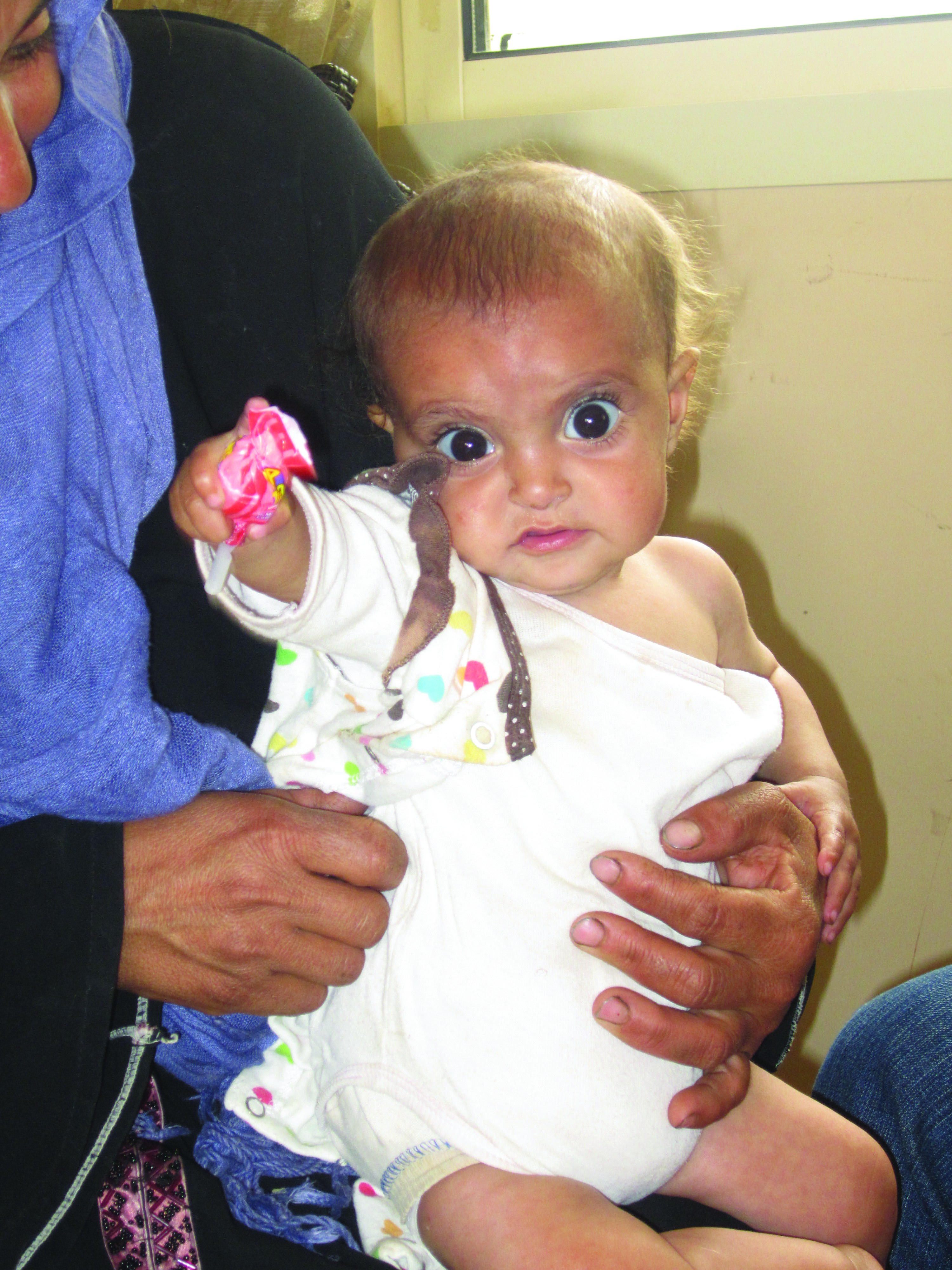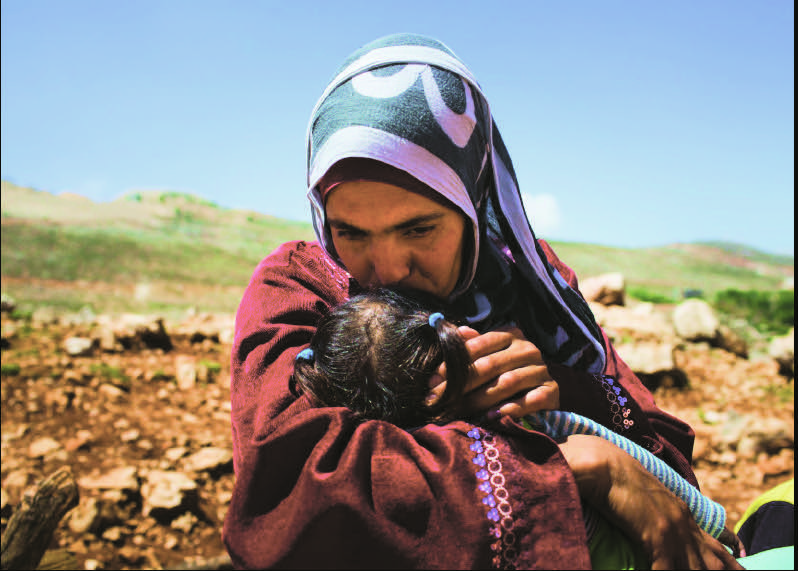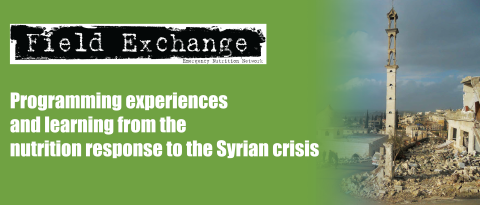UNICEF experiences of the nutrition response in Lebanon
By Najwa Rizkallah
 Najwa Rizkallah was Nutrition Specialist with UNICEF Lebanon until September 2014, having led the nutrition in emergencies programme in Lebanon for Syrian refugees since October 2013. Before that she worked as a nutrition specialist in the State of Palestine (SoP) office. She has many years of nutrition experience in emergency and non-emergency settings. Previously she was head of the Nutrition Department at UNRWA, as well as consultancy positions and lecturing. She has a Doctoral degree in Epidemiology and Population Health and a Master’s Degree in Nutritional Sciences. She is currently an Emergency Nutrition Specialist, El Fasher, Darfur, North Sudan.
Najwa Rizkallah was Nutrition Specialist with UNICEF Lebanon until September 2014, having led the nutrition in emergencies programme in Lebanon for Syrian refugees since October 2013. Before that she worked as a nutrition specialist in the State of Palestine (SoP) office. She has many years of nutrition experience in emergency and non-emergency settings. Previously she was head of the Nutrition Department at UNRWA, as well as consultancy positions and lecturing. She has a Doctoral degree in Epidemiology and Population Health and a Master’s Degree in Nutritional Sciences. She is currently an Emergency Nutrition Specialist, El Fasher, Darfur, North Sudan.
Thanks to the International Orthodox Christian Charities (IOCC) and Relief International for sharing the data included in this article.
Undernutrition is a silent, yet growing concern in Lebanon amongst children under 5 years, as Syrian refugee numbers increase steadily and the economic resources of both refugees and host communities diminish. Those who are most at risk of malnutrition are the least likely to seek medical attention, as they cannot afford the cost of travel, doctor’s fees or medication. While the Lebanese public health system is willing to respond, they lack the resources and expertise to do so without support from other agencies.
One of UNICEF’s foremost priorities in emergencies is to prevent death and malnutrition in the affected population, particularly amongst vulnerable groups: infants, children, pregnant women and breastfeeding mothers. This role includes screening children and women, supporting treatment of acute malnutrition, and raising awareness around appropriate infant and young child feeding (IYCF) practices, as well as prevention of micronutrient deficiencies.
UNICEF supported programming to date
 A nutrition assessment of the Syrian refugees in Lebanon conducted in Sept 2012 recorded a global acute malnutrition (GAM) rate of 4.4%, which is categorised by WHO as an ‘acceptable’ prevalence of malnutrition. The management of acute malnutrition was a very new area for the health care system in Lebanon. Prior to the Syria crisis, acute malnutrition was not at all common in Lebanon and only tended to occur where there was co-morbidity.
A nutrition assessment of the Syrian refugees in Lebanon conducted in Sept 2012 recorded a global acute malnutrition (GAM) rate of 4.4%, which is categorised by WHO as an ‘acceptable’ prevalence of malnutrition. The management of acute malnutrition was a very new area for the health care system in Lebanon. Prior to the Syria crisis, acute malnutrition was not at all common in Lebanon and only tended to occur where there was co-morbidity.
Given the low capacity and in preparedness for a rise in caseload, UNICEF and IOCC moved to scale up capacity of public health providers for the detection, monitoring, and treatment of acute malnutrition. This decision was also informed by anecdotal reports by partners at the health working group of emerging cases of malnutrition among children and poor know-how of how to manage them, and the deaths of four SAM children, at one hospital in Beqaa Valley, attributed to lack of experience in SAM treatment. In addition to these activities, UNICEF undertook to ensure the timely and efficient distribution of programmes supplies, including micronutrient supplements for children and pregnant and lactating women (PLWs), as well as the development of Behaviour Change Communication (BCC) materials on malnutrition management and IYCF in emergencies (IYCF-E) in partnership with IOCC.
Capacity development
As part of the scale up effort, UNICEF supported the capacity building and skills development of people at international, United Nations (UN) and national organisation levels working on nutrition in Lebanon1. A Nutrition in Emergencies (NIE) training course was conducted in Jordan and the main partners of UNICEF Lebanon attended a NIE training in Jordan in June 2013. This training helped International Orthodox Christian Charities (IOCC) and Relief International (RI) to scale up their work on management of acute malnutrition with the support of UNICEF. Later on, UNICEF contracted IOCC to train community mobilisers, nurses, and paediatricians on CMAM and IYCF-E. More than 240 doctors, nurses, paediatricians and community mobilisers from the MOPH, IMC, RI, ACF, WFP, UNHCR and AVSI were trained by IOCC and UNICEF staff.
In June 2014, a NIE training was conducted in collaboration with the American University of Beirut (AUB) and University College London (UCL). This professional training has been established over a number of years2. Thirty-five participants attended the training from Lebanon and other countries in the region affected by the Syrian crisis (including those working in Syria) as well as MOPH staff. This training helped attendees improve their skills to better respond to nutritional needs of those affected by emergencies.
Acute malnutrition treatment services
In Lebanon, UNICEF is responsible for programmes that treat SAM cases without complications at community level (within primary health care centres (PHCs)), programmes that treat SAM cases with complications as in-patients (in hospital) in collaboration with UNHCR3 and programmes that treat MAM children (at PHC level). WHO is not involved in acute malnutrition treatment (though WHO protocols are used) and WFP is focused on food security. UNHCR covers the cost of hospital stay and primary healthcare level consultations for all malnourished children (SAM with complications) and supports the salaries of IOCC lactation specialists who provide one-on-one breastfeeding counselling. UNHCR also supports the salaries of IOCC health and nutrition staff. All of this work is undertaken in coordination and cooperation with the Ministry of Public Health (MOPH) and other main partners such as International Orthodox Christian Churches (IOCC), Relief International (RI) and Action Contre la Faim (ACF).
UNICEF is supporting two work modalities to scale up the treatment of malnutrition. The first modality, which is conducted through IOCC4, is community based screening and active case finding for acute malnutrition, then treatment at primary health and secondary health centre depending on the cases. This involves community mobilisers screening children aged 6-59 months for acute malnutrition at the community level using mid upper arm circumference (MUAC) and bilateral oedema. Children identified with either severe acute malnutrition (SAM) without complications or moderate acute malnutrition (MAM) are referred to PHC clinics for treatment5. Children with complicated SAM are referred to secondary care for treatment. The second modality is similar in terms of screening but the treatment is conducted at home in the informal tented settlements (ITS) and children are followed up on a weekly basis after receiving either Ready to Use Supplementary Food (RUSF) or Ready to Use Therapeutic Food (RUTF) as appropriate. More than 55,000 children have been screened for malnutrition since January 2014.
IOCC supports acute malnutrition treatment at PHCs and at the inpatient level and RI supports management in mobile clinics. For IOCC programming, at the outpatient level (until end of July 2014) a total of 826 cases were treated (593 cases of MAM and 233 cases of SAM). At the inpatient level (until end of July 2014), 218 cases were admitted including complicated SAM, complicated MAM, children with malnutrition secondary to disease, and infants with malnutrition. For RI programming, 519 children have been admitted and 453 discharged (87.3% cure rate, 10% defaulter rate). Fourteen children are currently under treatment (July 2014). For breakdown for SAM and MAM cases, see Table 1.
Table 1: Number of children under 5 years with MAM and SAM managed as outpatients though the home based treatment as part of RI programming, November 2013-June 2014.
Cases |
SAM cases |
MAM cases |
|
Identified |
58 |
461 |
|
Discharged |
42 |
411 |
|
Defaulters |
9 |
43 |
|
Under treatment |
7 |
7 |
UNICEF also supplies anthropometric equipment and therapeutic and supplementary foods (RUTF, RUSF, high protein/energy biscuits, and emergency food rations BP5) for home based treatment and or treatment at the PHC clinics. For hospitals, UNICEF provides anthropometric equipment, therapeutic food and medications such as F75, F100, ReSomal and antibiotics.
Data quality issues
To inform ongoing nutrition programming in Lebanon and with concerns that the nutritional status of refugees had deteriorated, the nutrition community (involving UNICEF, UNHCR, WFP, IOCC and WHO) undertook an inter-agency nutrition assessment of Syrian refugees between October and December 2013 to obtain an update of the nutrition situation. It was led by a UNICEF consultant. It revealed that GAM rates (based on WHZ) in the Beqaa Valley and in Northern Lebanon had almost doubled compared to the 2012 assessment. The GAM rate for refugees was 5.9% in all Lebanon, 8.9% in Beqaa and 6.7% in Northern Lebanon. In the assessment, MUAC identified no cases of acute malnutrition. Translating these figures into numbers meant that an estimated 10,504 children in all of Lebanon (including 5,279 children in Beqaa and 3,410 children the North) were acutely malnourished and in need of treatment. The nutrition situation was reported as worst in areas where access to safe water, hygiene and sanitation were inadequate.
The interagency 2013 nutrition survey results presented to the nutrition stakeholders in Jan/Feb 2014 endorsed the rationale for scale up of acute malnutrition treatment. However inconsistencies in the findings were noted by the Centres for Disease Control and Prevention (CDC) and by UNICEF MENARO when compared with assessments conducted among Syrians in neighbouring countries such as Jordan. This led to a data quality verification exercise by UNICEF Lebanon facilitated by UNICEF MENARO with support from CDC.
It was found that the original height data of multiple children was altered after data collection in an irregular way, creating additional cases of GAM in all children for whom the height was changed without any notification of the height change in the methodology or anywhere else in the assessment. After changing the height values to their original levels and recalculating the prevalence of anthropometric indicators, the aggregate GAM for children aged 6-59 months from Syria was 2.2%, considerably lower than the original assessed prevalence of 5.9% (see Table 2). Differences were observed across the assessed locations (see Table 3).
Table 2: Original and corrected acute malnutrition prevalence amongst Syrian refugees in Lebanon (2013 assessment)
|
|
Original analysis: prevalence in 2013 |
|
Corrected analysis: prevalence in 2013 |
|
||
|
|
% |
n |
% |
n |
||
|
GAM |
5.9% |
81/1384 |
2.2% |
30/1352 |
||
|
MAM |
4.8% |
67/1384 |
1.8% |
24/1352 |
||
|
SAM |
1% |
14/1384 |
0.4% |
6/1352 |
||
|
Oedema |
0.4% |
6/1384 |
0.4% |
6/1384 |
||
Table 3: Original and corrected GAM prevalence amongst Syrian refugees in specific locations (2013 assessment)
|
|
Original analysis: prevalence in 2013 |
Corrected analysis: prevalence in 2013 |
|
Bekaa valley |
8.9% |
4.5% |
|
Northern Lebanon |
6.7% |
3.9% |
|
South Lebanon |
4.3% |
0.3% |
|
Beirut/Mount Lebanon |
4.1% |
0.5% |
In addition, UNICEF and its partners undertook a nutrition screening campaign in the Beqaa Valley in May to June 2014 to identify cases of acute malnutrition and to verify the results of the 2013 nutrition assessment. Of 16,531 children under 5 years screened using MUAC, 828 cases were referred to the PHC facilities for further investigation. This included children whose MUAC was 12.5-13.5cm since routine screening by Relief International (RI) identified children whose MUAC was normal but whose WHZ was not. Referral was made to ensure children were caught as soon as possible. Only 518 children visited the PHC facilities for further check-up and treatment, of whom 25 children were found to have SAM (5% of referrals) and 77 cases (15% of referrals) found to have MAM, based on MUAC. When data were classified based on WHZ, the prevalence amongst referred cases was 1.8% (6/336) for SAM and 9.5% (32/336) for MAM6. Data on co-morbidity are not available.
Challenges
 Issues of data quality
Issues of data quality
The issue with data quality that has unfolded in Lebanon around the 2013 nutrition assessment has been significant. The consultant leading on the survey was trained in SMART but, it later transpired, had outdated training. The problem was compounded by difficulties accessing the raw data from the consultant engaged by UNICEF before the results were released. At the time, no organisation doubted the figures, but many expressed surprise with the high GAM rate compared to the previous year. WFP queried the GAM rates and requested data access which was not granted at the time, except for anaemia data which were shared with UNHCR only. This all came at a time when there were reports of increased caseloads of acute malnutrition from organisations working in the field and the SAM-associated deaths in Bekaa Valley hospital. UNHCR and WFP requested the data to undertake additional analysis. However, data were never shared until the consultancy was over and the results were announced.
To learn from the experience and ensure data quality in future assessments, a 3 day workshop was held by UNICEF MENARO in Amman, Jordan in July 2014, to update the participants with techniques on data quality verification based on SMART software for data management and data analysis techniques. The workshop was facilitated by Dr. Oleg Bilukha and Ms. Eva Leidman from CDC Atlanta. Sixteen participants attended the workshop from UN agencies (UNICEF, UNHCR, and WFP), Save the Children, Medair, MOPH representing Lebanon, AUB, Iraq, Syria, Geneva, Jordan and the regional office. The target audience was UNICEF nutrition focal persons who had been involved in nutrition assessments and UNICEF immediate counterparts collaborating in these assessment exercises in Syria, Lebanon, Iraq and Jordan, particularly the MOH and UNHCR. All attendees were focal persons involved in data management and will be expected to play a critical role in ensuring data quality in future assessments. The primary purpose of this data quality clinic was to review the data generated to date by a series of nutrition assessment in response to the Syria crisis, subjecting it to quality checks and updating the participants with techniques on data quality verification. Participants were exposed to the Emergency Nutrition Assessment (ENA) for SMART software for data management and data analysis techniques; for the majority it was their first time using ENA for SMART. During the workshop, a brainstorming gave rise to the recommendations for the way forward outlined below.
The case for scaled up treatment of acute malnutrition
The corrected GAM prevalence figures, the programme admission figures and the 2014 screening results confirmed that there was no nutrition crisis in Lebanon. On reflection this indicated a need to shift attention in the nutrition programme. The ‘true’ scale of risk of acute malnutrition has proven to be lower than originally believed and therefore requires a different approach/programming emphasis than that adopted until now. On the positive side, nutrition programming has helped develop capacity to treat cases of acute malnutrition in country, and there are examples of success in individual case management in this regard. However, we believe that through collective effort, we have managed to reach children before developing MAM and SAM. Two outstanding challenges are the management of acute malnutrition among infants less than 6 months, especially SAM cases, and management of acute malnutrition among pregnant/lactating women.
Micronutrients
The prevalence of anaemia in the 2013 assessment was unaffected by data quality issues. The prevalence of anaemia in children 6-59 months for all Syrian refugees in Lebanon was 21.0%; children aged 6-23 months were most affected (31.5%). Regionalised data found the highest prevalence in North Lebanon (25.8% amongst 6-59 months, 42.9% amongst 6-23 months). The total anaemia prevalence for non-pregnant women of reproductive age (15-49 years) were for all Syrian refugees in Lebanon 26.1%. Women who live in Beirut and Mount Lebanon had the highest prevalence (29.3%).
Micronutrient provision has been a challenge. In Lebanon, no one organisation was willing to undertake blanket distribution of micronutrient powders (MNPs) for children aged 6-59 months except RI through their mobile medical units. Hence the nutrition sub-working group, led by the MOPH, recommended that MNPs be distributed at PHCs after the child is seen by the paediatrician. Pregnant and lactating women were receiving iron folic acid tablets through the Medical mobile units and or the PHC centres of the MOPH.
The problems of high pre-crisis prevalence of anaemia and stunting and the risks of increased prevalence in the crisis were discussed amongst UNICEF and the nutrition community involved in the response. Most recently, this has led to a move to develop strategies and national protocols for the management of malnutrition and the micronutrient supplementation. A draft nutrition strategy has been developed and discussed with the technical committee that emerged from the nutrition sub-working group. This strategy is based on the UNICEF-MOPH work plan and work with partners. More meetings will take place to finalise the strategy
The way forward
 The reviewed and corrected nutrition data from Lebanon shows that there is not a nutrition crisis and the feared decline in nutrition status has not materialised. Given this, emphasis on acute malnutrition treatment can be reduced and more emphasis placed on prevention of stunting, anaemia prevention and treatment, and improvement in IYCF practices including exclusive breastfeeding. Advocacy will be necessary to position nutrition as a priority sector in order to sustain the low levels of acute malnutrition.
The reviewed and corrected nutrition data from Lebanon shows that there is not a nutrition crisis and the feared decline in nutrition status has not materialised. Given this, emphasis on acute malnutrition treatment can be reduced and more emphasis placed on prevention of stunting, anaemia prevention and treatment, and improvement in IYCF practices including exclusive breastfeeding. Advocacy will be necessary to position nutrition as a priority sector in order to sustain the low levels of acute malnutrition.
Recommendations for nutrition programming were developed at UNICEF regional level together with participants at the data quality workshop in Amman, for UNICEF country offices to adapt as appropriate. In Lebanon, these were shared with the nutrition sub-working group led by the MOPH, which has led to modifications to existing draft nutrition strategies (prepared with the MOPH and other partners including IOCC, RI, WFP, and ACF as the main nutrition players in Lebanon). Recommendations for nutrition programming are as follows:
Recommendation 1: Infant and young Child feeding
- Strengthen positive IYCF practices (breastfeeding & complementary feeding, including awareness raising through community mobilisation)
- Integrate education and communication strategies in health centres
Recommendation 2: Micronutrient intervention
- Improve dietary diversity through food security initiatives
- Support food fortification as part of the national programmes rather that refugee/ IDP specific programmes
- Support supplementation – Vitamin A, iron and folate - in PHC services
- Support delivery of micronutrient powders (MNP) as anaemia is a proxy for other micronutrient deficiencies. UNICEF provides the micronutrient supplements and sprinkles to MOPH, IOCC, RI and others who distribute at the community level after the child has been g seen by a physician and or PHCs
- Support maternal nutrition through micronutrient supplementation
Recommendation 3: Treatment of acute malnutrition at minimal scale
For ethical reasons, case management should be in place, therefore:
- Ensure the capacity, guidelines and minimal supplies exist (preparedness) for treatment of acute malnutrition
- Ensure integration of the nutrition programme in PHC facilities (screening and treatment of malnutrition cases) which will allow for sustainability and provide services in both emergency and non-emergency situations
Recommendation 4: Rigorous monitoring of the situation (screening/ surveillance/periodic survey)
- Screening of the refugee population on arrival
- Integrated screening in regular public health work (eg EPI campaigns)
- Facility based screening
- Periodic assessment/surveys where there are substantial treatment programmes/caseloads for acute malnutrition (these surveys should include coverage assessment) or if requested by country offices
- Establish a nutrition surveillance system in collaboration with the MOPH and IOCC. This is in the early stages of development and will aim to monitor the growth of children and inform policy-makers on where malnutrition problems exist for taking further actions.
Recommendation 5: Integrated response
Promote an integrated response through delivery of a minimum package of health and nutrition response, including immunisation, disease treatment, awareness raising, food security, water and sanitation services, shelter, to prevent malnutrition with a focus on the first 1000 days (pregnancy and until the child is 2 years of age) to prevent stunting, reduce LBW and to improve maternal nutrition
- Strengthen coordination and advocacy for nutrition as a priority sector. The recently formed nutrition sub working group and its respective members has a key role and responsibility for effective coordination, gap analysis, information flow, strategy development and harmonisation, and to foster partnership.
A nutrition work plan was developed in May 2014 (signed June 2014) with the MOPH and its partners in an attempt to institutionalise the nutrition programme within the MOPH PHC centres and hospitals with a view to building resilience and a sustainable capacity in-country. This has involved a number of activities:
- Establishment of a coordination body (nutrition sub-working group) in May 2014 to respond to nutrition in emergencies. Prior to May 2014, there was no official coordination body on nutrition; ad hoc meetings were hosted by UNICEF to coordinate activities and nutrition was covered as a topic in the health and nutrition working group. The MOPH is lead agency with UNICEF as co-lead, in addition to IOCC and WFP who will co-lead alternatively on a six month basis with UNICEF. UNICEF proposed this co–lead approach to build capacity of partners. The group meets every month and reports to the health and nutrition working group.
- Capacity building of doctors, paediatricians, nurses and community mobilisers.
- Community based screening and active case finding for acute malnutrition
- Screening children under 2 years regarding breastfeeding practice at the PHC and community levels. The identified mothers with suboptimal feeding practices are supported by lactation specialists who provide one-on-one counselling. This component is supported by UNHCR.
- Outpatient management of acute malnutrition. This service is integrated within the PHC centres/facilities of the MOPH. UNICEF is supporting IOCC in activating 40 PHC all over Lebanon (see article by IOCC in this issue of Field Exchange).
- Inpatient management of acute malnutrition. Five hospitals have been ‘activated’ to treat inpatient malnourished children.
- Supporting IOCC in initiating a clinic based nutrition surveillance system at the MOPH primary health centres (PHC) centres that screen, track, monitor and interpret the nutritional status data of children under five years old affected by the crisis.
For more information, contact: Najwa Rizkallah, email: nrizkallah@unicef.org, najwarizkallah@hotmail.com
1 See also the article by UNICEF on capacity development in the region, in this edition of Field Exchange
2See article by AUB in this edition of Field Exchange and visit www.nietraining.net
3UNICEF provides all supplies and technical knowhow and UNHCR pays for the hospital stay and salaries of IOCC dieticians.
4 See field article by IOCC in this edition of Field Exchange.
5 In the field and at the initial screening at the PHC facilities, MUAC is used and the cut off points used are: <11.5 cm for SAM, 11.5-12.4 cm MAM, >12.5 cm normal. In addition to MUAC measurements, heights and weights of children are measured and weight for height z scores are used to classify children using the following cut-offs: MAM (≥-3 and <-2)and SAM (WHZ<-3 z scores)
6 Weight and height data was available for a reduced number of children due to some discrepancies in measurement. There remain challenges in sustaining quality measurement of height and weight with high staff turnover.


